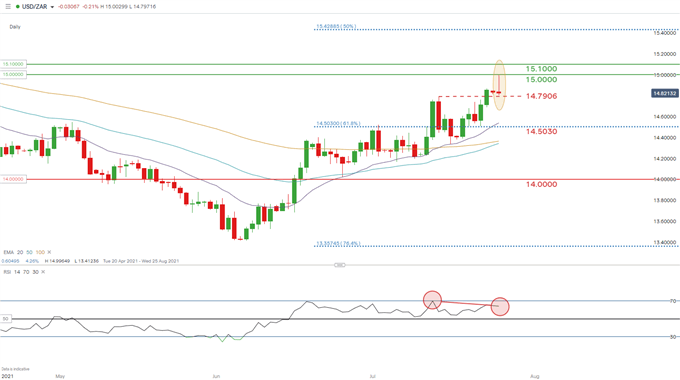RAND ANALYSIS
- South African lockdown restrictions eased.
- Fed interest rate decision on Wednesday.
- Shooting star printing on daily chart.
ZAR FUNDAMENTAL BACKDROP
TOUGH DECISIONS FOR SOUTH AFRICAN PRESIDENT
President Cyril Ramaphosa announced on Sunday evening that the country would be moved to Alert Level 3 from Level 4 which reduces limitations on COVID-19 protocols. Restaurant and hotel trading, interprovincial travel and the resumption of alcohol sales (at pre-defined times) are some of the key highlights to prior economic constraints. The President also emphasized the negative economic impact of the recent civil unrest which will likely hamper any forecasted rand gains.
SPOTLIGHT ON TAPER TALK AS NO POLICY CHANGE ANTICIPATED FROM FEDERAL RESERVE
The Fed meeting on Wednesday (see calendar below) will have financial market participants glued to their screens as any additional clarity on tapering will be welcomed. Fed Chair Jerome Powell has thus far stuck to the transitory stance regarding inflation as well as their large focus on the labour market which has yet to reveal employment anywhere near desired levels.
USD/ZAR ECONOMIC CALENDAR

Source: DailyFX economic calendar



In June, we saw the Fed dot plot shift to 2023 from 2024 which surprised markets. This may not be the case in this meeting however, with market conditions changing constantly anything can happen. U.S. treasury yields have been headline news of recent as 10-year yields fell this week to 1.2813% (as of this writing). These lower yields are supportive of monetary stimulus which will ratify those with hawkish viewpoints.
Traditionally, Emerging Market (EM) currencies tend to abate when upcoming Fed announcements appear on the calendar. This usually favors a move to the “safer” dollar as volatility is sucked from the market. Although the probability for surprise is low, ZAR strength may be minimal leading up to the announcement.
This being said, USD/ZAR could likely pullback to the 14.5000 zone in Q3. After which, my forecast remains bullish on USD/ZAR from Q4 onwards as more actionable Fed policies are probable later this year.
GET YOUR Q3 RAND FORECAST HERE!
TECHNICAL ANALYSIS
USD/ZAR DAILY CHART

Chart prepared by Warren Venketas, IG
The daily USD/ZAR chart shows a strong start on Monday with bulls testing the 15.0000 psychological support zone in early trading. Since then, upside impetus has dissipated as indicative by consequent price action movement. The result has been the formation of a shooting star candlestick pattern (yellow) suggestive of an ensuing bearish reversal. Should today’s daily close follow the confines of the shooting star – long upper wick and small candle body, further downside may be expected.
Additional substantiation for short-term bears comes from the Relative Strength Index (RSI) which is currently exhibiting bearish divergence – price action trends upwards while the RSI prints lower.
Resistance levels:
- 15.0000
- 15.1000
Support levels:
- 14.7906
- 14.5030
--- Written by Warren Venketas for DailyFX.com
Contact and follow Warren on Twitter: @WVenketas






